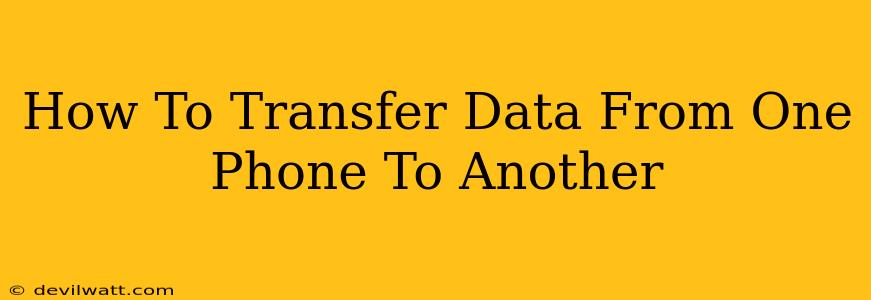Switching phones shouldn't mean losing your precious memories and important data. This comprehensive guide will walk you through various methods to transfer data from your old phone to your new one, ensuring a smooth and hassle-free transition. Whether you're moving from Android to Android, iPhone to iPhone, or even across operating systems, we've got you covered.
Understanding Your Data Transfer Options
Before diving into the specifics, it's essential to understand the different avenues available for data transfer. The best method for you will depend on several factors, including your phone's operating system, the amount of data you need to transfer, and your technical comfort level. We'll cover the most popular and efficient options:
1. Cloud Services: The Wireless Wonder
Cloud services like Google Drive (Android) and iCloud (iOS) provide a convenient way to back up and restore your data wirelessly. This is ideal for transferring contacts, photos, videos, documents, and more. Simply back up your data to the cloud on your old phone and then restore it on your new device. This method is particularly useful for large data sets.
Pros: Wireless, convenient, suitable for large amounts of data. Cons: Requires a stable internet connection, may take time depending on data size.
2. Direct Phone-to-Phone Transfer: Quick and Easy
Both Android and iOS offer built-in features for direct phone-to-phone data transfer. This method uses Bluetooth or a direct cable connection (depending on the devices and operating systems) to transfer data quickly and efficiently. This is a great option for smaller data sets or when a fast transfer is prioritized.
Pros: Fast, easy, no internet connection required. Cons: May not support all data types, requires physical proximity of devices.
3. Using a Computer: The Versatile Approach
Transferring data via a computer offers a high degree of control and is suitable for various data types. You can use your computer to back up your phone's data and then restore it to your new phone. This method often uses dedicated software provided by your phone manufacturer or operating system.
Pros: Versatile, good for selective data transfer, offers control over the process. Cons: Requires a computer, may take time depending on data size.
Step-by-Step Guides: Transferring Data Between Different Phone Types
The following sections provide more detailed instructions for transferring data between different phone combinations:
Android to Android Transfer
- Using Google Account Backup: Back up your data (contacts, calendar, apps, etc.) using your Google account on your old Android phone. On your new phone, sign in with the same Google account to restore your data.
- Using Phone Clone App: Many Android devices come with a pre-installed phone cloning app or offer one through the Google Play Store. This app simplifies the process of transferring data directly from your old phone to your new one.
- Using a Computer: Connect your old phone to your computer via USB. Use file explorer to copy files (photos, videos, documents) from your old phone's storage to your computer, and then transfer them to your new phone.
iPhone to iPhone Transfer
- Using iCloud Backup: Back up your iPhone to iCloud. On your new iPhone, during the setup process, choose to restore from your iCloud backup.
- Using Quick Start: When setting up your new iPhone, it will detect your nearby old iPhone and prompt you to use Quick Start for a streamlined transfer.
- Using a Computer: Connect your iPhone to your computer via USB and use iTunes or Finder (depending on your macOS version) to back up and restore your data.
Android to iPhone Transfer (and vice-versa)
Transferring data between Android and iPhone requires a slightly more involved process. The most common methods are:
- Using Google Drive/iCloud: Back up your data to Google Drive (Android) and then download it to your iPhone via iCloud or vice-versa.
- Using Third-Party Apps: Several third-party apps specialize in transferring data between Android and iOS devices. These apps typically guide you through the process step-by-step.
Choosing the Right Method: Factors to Consider
- Data Size: For large amounts of data, cloud services or a computer are recommended. For smaller amounts, direct phone-to-phone transfer might suffice.
- Internet Availability: If you don't have a stable internet connection, direct phone-to-phone transfer or a computer method is preferable.
- Technical Skills: If you're less tech-savvy, using cloud services or a dedicated phone-cloning app is generally easier.
Remember to always back up your data before you begin the transfer process, as a precaution. With careful planning and the right method, transferring your data from one phone to another should be a straightforward and stress-free experience.

